Group Peer Assessment
What is a Group Peer Assessment?
A Group Peer Assessment calculates student contributions to a group assessment determined by multiple criteria and based on either:
- Peer Assessment Factor: An individual's contributions to group work by splitting 100 marks between all members of the group.
- Likert Question Type: The average score each student receives from all other group members.
Peer Assessment Factor (PAF)
Each team member will allocate 100 points between the members of their team. Justification of your distribution of points is essential if they are to be included in calculation of the final PAF. In particular, if the score given to any team member deviates from the average by 15% or more, you must include a written justification.
You will receive a single rating from each group member on a range of criteria. Below are examples of possible criteria:
- Your communication and collaboration with other team members and the timeliness of your work. This includes attendance and participation in team meetings; response and contribution to team communications (email, discussion board, etc); ability to work with and share findings with the team; and completion of assigned tasks in a timely manner.
- Your contribution to the project, that is the amount and quality of work contributed to the assignment. This includes participation in idea generation, calculations, theory discussion, writing and producing the submitted assignment, and the ability to contribute quality work at the standard required for the assignment.
- Your performance, i.e. your standard and completeness of work.
- Your timeliness, i.e. your ability to meet agreed contribution times.
For example, in a team of 4, the average score each team member will receive is 25 = ((100 points ) /4 members)). If you give someone 20, you are saying that the team member only deserves 80% of the score (80 out of 100) on the team assignment. If everyone on the team gives the same score, then that team member will have a PAF of 0.8 and their assignment score will be 0.8 times the team score on the team assignment. Therefore, in a team of 4, all scores of 85 and lower (and 115 and higher) MUST be justified to count.
Warning: If you game the system by giving yourself a higher score than the average at the expense of the others, it is likely that your team members will disagree with you by giving you different scores. As a result, the disagreement is easily reflected in the scores provided by all team members. If this happens, your score will be disregarded in the PAF factor (essentially you will lose your vote).
Note: If you give yourself a higher score than the average because you really deserve it, your team members are likely to agree with you by giving you high scores themselves. Again, this situation will be easily monitored by looking at the score dispersion. In this case, you will not lose your vote.
Submit a PAF Group Peer Assessment
- Access your Learn.UQ course.
- Select Assessment from the course menu.
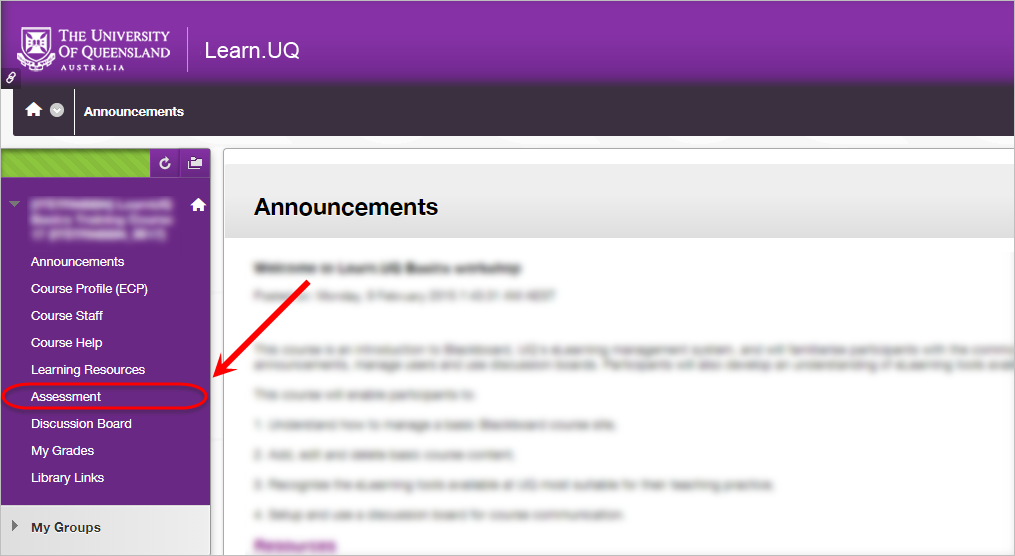
- Click on the required Group Peer Assessment folder.
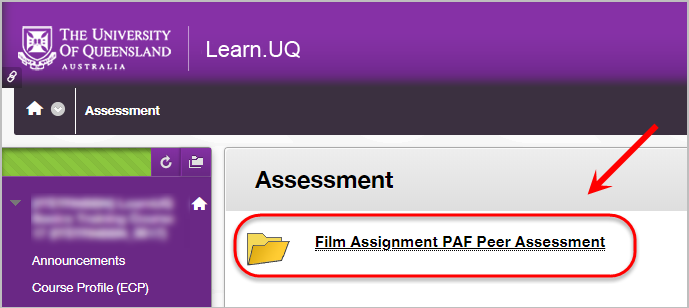
- Click on the required Group Peer Assessment.
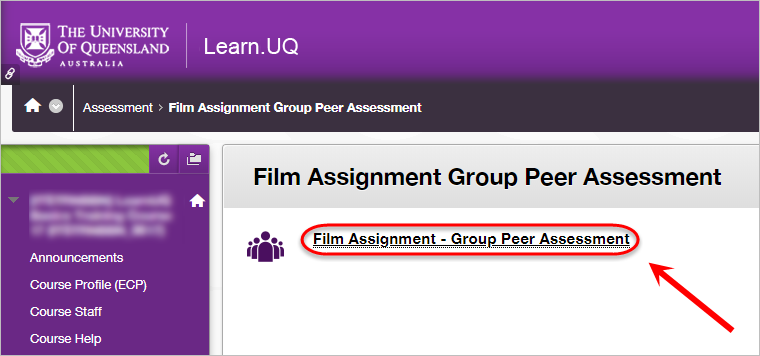
- In the text-field, enter the allocated percentage contribution (out of 100) for each group member.
- Repeat this step for all criterion.
Tip: Check the total which is displayed at the bottom of each criterion adds up to 100.
- In the Comment text-field, support your allocated percentage with a comment.
- Click on the Submit button.
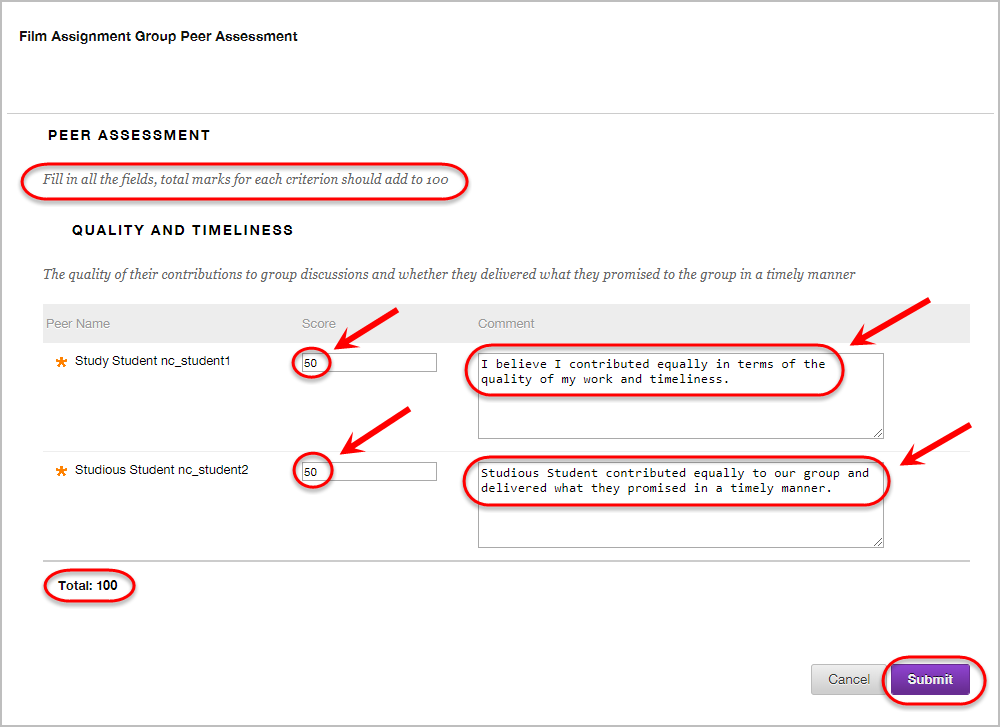
- A green bar will appear with a message confirming Your responses have been saved.
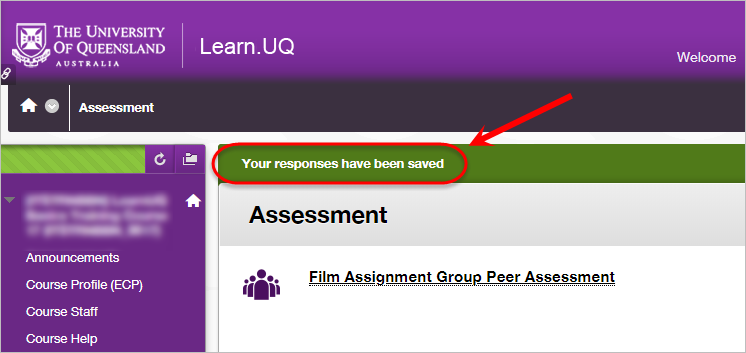
Likert
With the Likert option, students evaluate peers contributions to group work by answering Likert scale criteria questions. The tool will calculate the average score each student receives from all other group members for all criteria.
You will receive a rating from each group member based on a range of criteria. Below is an example of a possible criterion which is rated between 1 (being the lowest score) and 5 (being the highest score):
Attendance and contribution
- Did not attend or contribute to group meetings.
- Did attend some group meetings, but their contributions were minimal.
- Attended most group meetings and made required contributions.
- Attended most group meetings and made valuable contributions.
- Attended all group meetings and made exceptional contributions.
Submit a Likert Group Peer Assessment
- Access your Learn.UQ course.
- Select Assessment from the course menu.

- Click on the required Group Peer Assessment folder.

- Click on the required Group Peer Assessment.

- Allocate a 1 to 5 score to each group member using the radio buttons.
- Repeat this step for all criterion.
- In the Comment text-field, support your allocated score with a comment.
- Click on the Submit button.
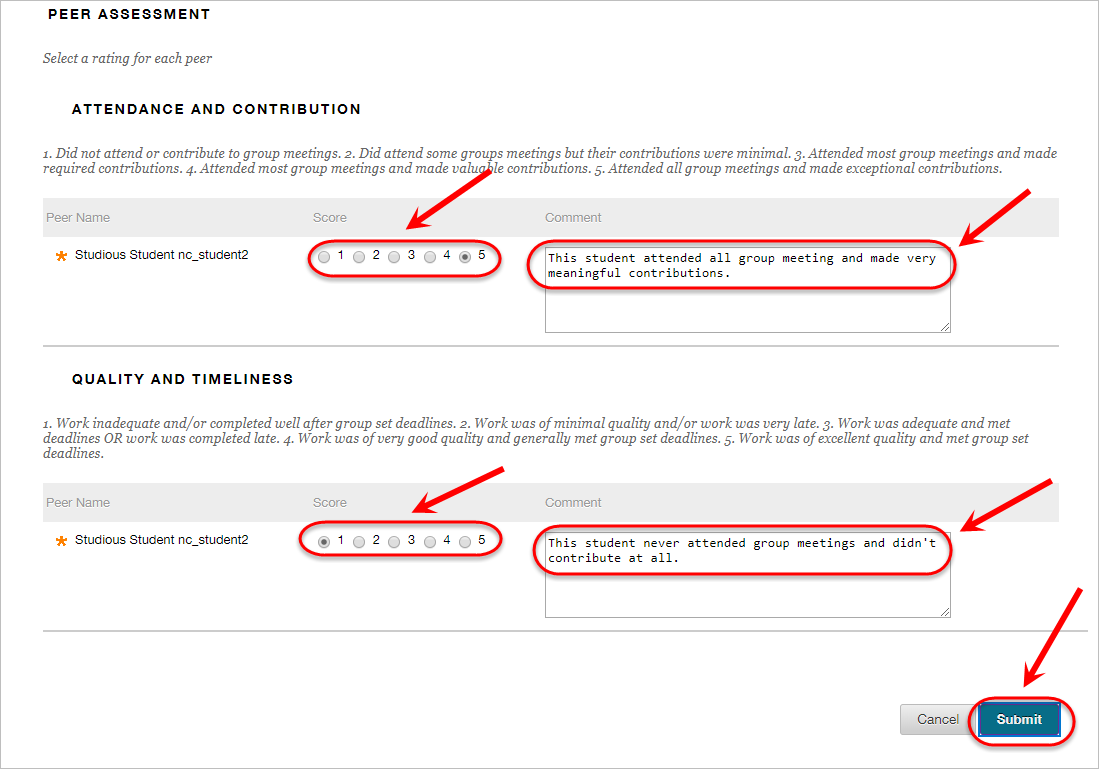
- A green bar will appear with a message confirming Your responses have been saved.

- Getting started with Learn.UQ
- The Learn.UQ welcome page
- Your Learn.UQ courses
- Archived Learn.UQ courses
- Collaborative tools
- Learn.UQ assessment
- Lecture recordings
- Learn.UQ (Blackboard) contacts
- Blackboard App
- 'my ePortfolio'
- Academic Integrity Modules (AIM)
- Access UQ Extend (Ultra)
- Blackboard Welcome Page Update
- Electronic Work-based Assessment
- Group Peer Assessment
- Inspera Assessment
- Learn.UQ Course Site Navigation
- Learn.UQ Notification Settings
- Learning Pathway
- Record video or audio through EchoVideo
- Reporting Technical Problems with eLearning Systems
- Submit a video assignment with EchoVideo (Ultra)
- Submit a video journal entry with EchoVideo (Ultra)
- Submit your Turnitin assignment (Ultra)
- UQ Extend
- Video assessment with Echo360
- View Turnitin Similarity Report and marks (Ultra)
- Virtual Classroom (Zoom)
- iThenticate